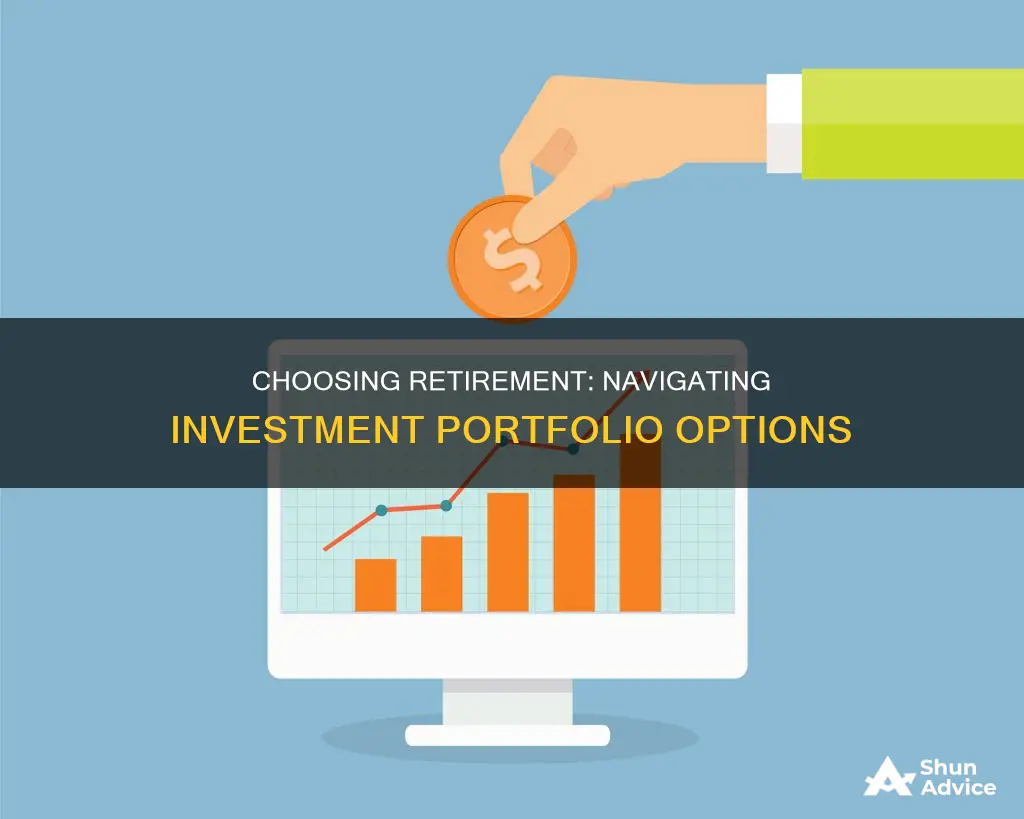
Choosing the right investment portfolio for retirement is a crucial step in ensuring financial security for the future. The process involves careful planning and consideration of various factors to create a sustainable strategy that meets individual needs and goals. From starting early to striking a balance between preservation and growth, there are several key aspects to selecting an investment portfolio for retirement.
Firstly, it is essential to define clear retirement goals and assess the time until retirement. The number of working years left is a significant factor in determining the investment strategy. The longer the time horizon, the higher the allocation to stocks or more volatile asset classes, providing potential for higher returns and better inflation protection.
Secondly, diversification is a key component of a robust retirement portfolio. Diversification can be achieved by investing in various asset classes, such as stocks, bonds, cash, and alternative investments. Diversification helps to reduce risk and enhance long-term growth prospects.
Additionally, it is crucial to consider risk tolerance when selecting an investment portfolio for retirement. As individuals approach retirement age, their risk tolerance often changes, leading to a shift in focus from growth to capital preservation and income generation.
Lastly, it is beneficial to seek professional advice and utilise resources, such as model portfolios, to guide investment decisions. Regular reviews and adjustments to the portfolio are also essential to ensure it remains aligned with the individual's goals, risk tolerance, and market conditions.
By following these steps and tailoring the strategy to personal circumstances, individuals can build a robust investment portfolio to support their retirement goals.
| Characteristics | Values |
|---|---|
| Investment portfolio | Includes all the investments you have in various accounts |
| Accounts | Employer-sponsored plans (401(k)s), IRAs (traditional, Roth, SEP, SIMPLE), Taxable brokerage accounts, Robo-advisor accounts, Cash in savings, money market accounts, certificates of deposit (CDs) |
| Assets | Stocks, Bonds, Exchange-traded funds (ETFs), Mutual funds, Commodities, Futures, Options, Real estate |
| Goals | Growth, Income, Capital preservation |
| Risk tolerance | Volatility in the value of investments an investor is willing to endure |
| Active vs. Passive management | Active management results in higher investment returns but higher transaction fees; Passive management has lower fees |
| Robo-advisors | Digital platforms that allocate and manage a portfolio according to preset algorithms; Cost less than human managers but may be disadvantageous in some cases |
| Diversification | Reduces the effects of risk and negative performance of any one asset |
| Time horizon | The number of years until retirement |
| Emergency fund | Covers three to six months of expenses |
What You'll Learn

Stocks, bonds, and cash investments
When it comes to planning for retirement, it's important to know how to achieve your investment goals. Asset allocation is the diversification of your retirement account across stocks, bonds, and cash. The older you are, the less investment risk you can afford to take. As you get closer to retirement age, your risk tolerance decreases, and you can't afford any wild swings in the stock market.
- Adjust your asset allocation according to your age: When you have a short investment timeline, market corrections can be especially problematic, both emotionally and financially. Adjusting your allocation according to your age helps you bypass these problems. For example, if you're younger than 50 and saving for retirement, you can consider investing heavily in stocks as you have plenty of time until you retire and can ride out any market turbulence. As you reach your 50s, consider allocating 60% of your portfolio to stocks and 40% to bonds, adjusting based on your risk tolerance. Once you're retired, you may prefer a more conservative allocation of 50% in stocks and 50% in bonds.
- Consider your innate risk tolerance: Your age isn't the only factor in asset allocation. Your innate risk tolerance is also important. If you're 65 or older and seasoned enough to stay calm through market cycles, you can buy more stocks. If you're 25 and every market correction makes you nervous, aim for a 50/50 split between stocks and bonds.
- Don't let stock market conditions dictate your allocation strategy: When the economy is doing well, it can be tempting to believe that the stock market will continue to rise indefinitely. However, it's important to follow a planned asset allocation strategy because you can't time the market and don't know when a correction is coming.
- Diversify your holdings within each asset class: It's important to diversify across stocks, bonds, and cash, but you should also diversify within these asset classes. For example, hold 20 or more individual stocks or invest in mutual funds or exchange-traded funds (ETFs). Diversify your bond holdings by investing in bond funds or varying your holdings across bond maturities, sectors, and types.
- Consider target-date funds: If you don't want to actively manage your asset allocation, you can invest in a target-date fund, which manages asset allocation for you. These funds are diversified across and within asset classes, and the allocation takes your age into account. However, they don't account for your individual risk tolerance or potential changes in your circumstances.
- Review and rebalance your portfolio periodically: It's important to review your financial portfolio periodically and rebalance when needed. Over time, market movements can shift your asset allocation away from your objectives. For example, when stock prices rise, stocks might make up a higher percentage of your portfolio than intended. To rebalance, you could sell some of your stock positions and use the proceeds to purchase assets in other classes, such as cash alternatives and bonds.
Remember, the most fundamental decision in investing is the allocation of your assets. By choosing the right mix of stocks, bonds, and cash investments, you can work towards generating sustainable long-term returns and building a retirement portfolio that meets your goals and risk tolerance.
Rich People's Investment Strategies
You may want to see also

Risk tolerance and time horizon
When selecting an investment portfolio for retirement, it is important to consider your risk tolerance and time horizon. These two factors are crucial in determining the most suitable investments to achieve your financial goals.
Risk tolerance refers to how much risk you are willing and able to take on in your investments. It is influenced by various factors such as age, financial situation, and investment experience. Younger investors are generally considered to have a higher risk tolerance, as they have a longer time horizon and can afford to take on more risk. However, it is important to note that risk tolerance is not solely based on age, and other factors such as net worth and investment goals should also be considered. For example, an older investor with a high net worth and stable financial situation may still have a relatively high risk tolerance.
Time horizon, on the other hand, refers to the period of time you expect to hold an investment. This can range from a few days to several decades. Your time horizon will impact the level of risk you are willing to take on. Generally, investors with a longer time horizon are willing to take on more risk, as they have more time to recover from any market downturns. For example, a young professional with a 401(k) plan would have a long-term investment horizon, spanning decades, and could afford to take on more risk. On the other hand, investors with a shorter time horizon may prefer more conservative investments to minimize their risk exposure.
It is important to carefully consider your risk tolerance and time horizon when selecting an investment portfolio for retirement. These factors will help you determine the appropriate mix of stocks, bonds, and other investments to achieve your financial goals while staying within your comfort level for risk. It may be helpful to work with a financial professional to assess your risk tolerance and create a plan that aligns with your time horizon and investment objectives.
Additionally, it is worth noting that while age is a factor in determining your time horizon, it is not the only consideration. Other factors, such as financial goals, risk tolerance, income, and lifestyle, should also be taken into account when selecting your time horizon and investment portfolio.
The Investment Banker's Early Retirement Dream: Fantasy or Reality?
You may want to see also

Active vs. passive portfolio management
When it comes to selecting an investment portfolio for retirement, there are two main approaches: active and passive portfolio management.
Active Portfolio Management
Active portfolio management involves actively buying and selling securities based on market conditions, economic trends, or specific opportunities. The goal is to outperform a benchmark index or a peer group of funds by using superior research, analysis, and timing. Active portfolio managers may use various strategies, such as market timing, sector rotation, stock picking, short selling, hedging, or leverage, to achieve their objectives. This approach typically requires more frequent trading and higher fees than passive portfolio management.
The advantages of active portfolio management include:
- Flexibility: Active managers can buy stocks they believe will perform well and are not limited to a specific index.
- Hedging: Active managers can use techniques like short sales or put options to reduce risk.
- Tax management: Active managers can employ strategies to minimize capital gains taxes.
However, there are also disadvantages to consider:
- Higher expenses: Active funds charge higher fees due to the extensive research and analysis involved, as well as transaction costs from frequent trading.
- Higher risk: Active management aims to beat the market, which comes with greater risk.
- Management risk: Human fund managers can make costly mistakes.
Passive Portfolio Management
Passive portfolio management, on the other hand, involves holding a portfolio that replicates the performance of a predetermined index or market segment, such as the S&P 500. The goal is to match the returns of the index as closely as possible while minimizing costs and taxes. Passive portfolio managers do not attempt to beat the market but instead buy and hold the securities that make up the index. This approach typically requires less trading and lower fees than active management.
The advantages of passive portfolio management include:
- Lower expenses: Passive funds have lower fees since they simply mirror an index and do not require a staff of analysts.
- Consistency: Passive funds provide consistent returns that match the index.
- Tax efficiency: The buy-and-hold strategy of passive funds does not typically result in large capital gains taxes.
However, there are also some disadvantages to passive portfolio management:
- Lack of flexibility: Passive funds are limited to a specific index, and investors are locked into those holdings regardless of market performance.
- Smaller returns: Passive funds are not designed to beat the market and will not produce significant returns.
Choosing the Right Approach
The choice between active and passive portfolio management depends on various factors, such as an investor's risk appetite, return expectations, time horizon, cost sensitivity, tax situation, and personal preference. Some investors may even choose to blend the two approaches, depending on their goals and circumstances. It is important to weigh the risks and rewards of each approach and select the one that aligns best with your investment objectives and risk tolerance.
Tax-Free Investing: Strategies to Keep Your Profits
You may want to see also

Tax-efficiency and tax-deferred accounts
When it comes to retirement planning, tax-efficiency is a crucial consideration. Two common types of tax-advantaged accounts that can help you minimise taxes are tax-deferred and tax-exempt accounts. Here's what you need to know about these accounts and how they can benefit your retirement portfolio:
Tax-Deferred Accounts
Tax-deferred accounts, such as traditional Individual Retirement Accounts (IRAs) and 401(k) plans, offer an upfront tax break. You can contribute pre-tax income to these accounts, lowering your taxable income for the year. Taxes on the contributions and investment gains are deferred until you withdraw the funds in retirement. This means you will pay taxes on the withdrawals at your ordinary income tax rate at that time. Tax-deferred accounts are ideal for those in a higher tax bracket now, as they provide immediate tax savings. Additionally, these accounts often come with contribution caps and penalties for early withdrawals, so it's important to carefully consider the rules and restrictions.
Tax-Exempt Accounts
On the other hand, tax-exempt accounts, such as Roth IRAs and Roth 401(k)s, are funded with after-tax dollars. While there is no immediate tax advantage, the primary benefit of these accounts is that investment returns grow tax-free. Withdrawals from tax-exempt accounts in retirement are not subject to taxes. These accounts are well-suited for those who expect to be in a higher tax bracket later, as they can take advantage of tax-free withdrawals during retirement.
Choosing the Right Account
The ideal strategy may be to maximise contributions to both tax-deferred and tax-exempt accounts to diversify your tax strategy. However, this may not always be feasible. If you're currently in a lower tax bracket, funding a tax-exempt account like a Roth IRA could be a good option, as you can benefit from tax-free withdrawals in the future if your income and tax rate increase. Conversely, if you're in a higher tax bracket now, contributing to a traditional IRA or 401(k) can provide immediate tax savings. It's important to consider your current and future income expectations when deciding between these accounts.
Rust Belt: Why Invest Elsewhere?
You may want to see also

Emergency funds and financial goals
Emergency funds are an important part of financial planning for retirement. They are designed to cover unforeseen expenses or financial emergencies, such as medical issues, job loss, urgent home repairs, or car repairs. These funds are kept separate from regular savings to ensure that you have the funds available without relying on high-interest debt options like credit cards.
When it comes to emergency funds, there is no one-size-fits-all approach. The amount you should save depends on your personal situation, such as your income, expenses, and lifestyle. As a general rule, it is recommended to save three to twelve months' worth of living expenses, including committed repayments and savings. For dual-income households, three months' worth of expenses may be sufficient, while single-income households should aim for six months.
It is also important to consider the liquidity of your emergency fund, meaning how quickly you can access your funds without penalty. Savings accounts are a popular option as they are generally considered low-risk and offer FDIC insurance up to $250,000 per account. However, the interest rates on savings accounts are typically low and may not keep up with inflation.
- High-yield savings accounts: These online savings accounts offer higher interest rates than traditional savings accounts but may have higher minimum balance requirements and transaction limits.
- Certificates of Deposit (CDs) and CD Ladders: CDs offer higher interest rates and FDIC insurance, but you must lock up your money for a set period, typically ranging from three months to five years. CD Ladders help balance liquidity and higher interest rates by investing in CDs with varying maturity dates.
- Money Market Mutual Funds: These are a higher-yield alternative to high-yield savings accounts, offering higher interest rates and extreme liquidity, typically providing access to your money within one to three days. However, they may require higher minimum balances and do not offer FDIC insurance.
- Treasury Bills and Bonds: Backed by the US government, these are considered one of the safest investments. They provide a reliable source of income and a predictable stream of cash flow. To build an emergency fund, consider creating a laddered portfolio with varying maturity dates to ensure accessibility.
- Short-Term Bond Funds and Short-Term Municipal Bond Funds: These funds offer diversification, professional management, and a higher rate of return than traditional savings accounts while still being relatively low-risk. However, they are not FDIC-insured and may fluctuate in value.
By diversifying your emergency fund across different financial instruments, you can optimize both the returns and liquidity. It is important to work with a financial planner to determine the best investment strategy for your unique situation and to ensure that your emergency fund complements your other financial objectives.
Assessing Your Retirement Plan: Strategies for Evaluating Your Investment Portfolio
You may want to see also
Frequently asked questions
An investment portfolio is the sum total of all your investments across various accounts, including employer-sponsored plans, IRAs, taxable brokerage accounts, robo-advisor accounts, and cash in savings, money market accounts, or certificates of deposit (CDs).
Focus on growth now and income later. Take advantage of the power of compounding by starting to save and invest as early in life as you can. When saving for retirement, it is recommended to have a mix of investments that includes stocks, bonds, and cash.
This depends on your age and how close you are to leaving the workforce. When starting out, aim for an aggressive investment stance that's heavy on equities. You can adopt a more conservative investment stance as your risk tolerance changes (e.g. as you near retirement). Remember to always include a growth component in your portfolio to protect against inflation and ensure you don't outlive your savings.







